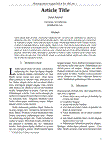COMPARISON OF PERCEIVED WEIGHT AS IDEAL AGAINST IDEAL BODY WEIGHT FORMULAS AND BODY MASS INDEX OF 22 KG/M2 IN YOUNG ADULT WOMEN.
SUMMARYIntroduction: Formulas of ideal body weight (IBW) including the body mass index (BMI) of 22 kg/m2 are used under the assumption to provide a healthy weight. Objective: We compare the perceived ideal body weight (PIBW) with the calculated IBW by formulas and the BMI of 22. Methods: We recruite...
| Autores principales: | , , , , , , , |
|---|---|
| Formato: | Artículo |
| Lenguaje: | español |
| Publicado: |
Universidad Autónoma de Nuevo León,Facultad de Salud Pública y Nutrición
2018
|
| Materias: | |
| Acceso en línea: | https://respyn.uanl.mx/index.php/respyn/article/view/356 |
| Sumario: | SUMMARYIntroduction: Formulas of ideal body weight (IBW) including the body mass index (BMI) of 22 kg/m2 are used under the assumption to provide a healthy weight. Objective: We compare the perceived ideal body weight (PIBW) with the calculated IBW by formulas and the BMI of 22. Methods: We recruited 705 women (20-25 y). Six common formulas and 2 published equations by our team were used. Results: Group regression analysis determined that including the frame size improves the agreement of formulas of Robinson et al, Hammond and Hamwi with the PIBW (p>0.05). Individually, the concordance analysis (higher % of differences <2 kg: PIBW - IBW by formula), determined that for a measured BMI <20, only the Faspyn 1 formula needs to be adjusted by frame size; while Robinson et al, Hammond, Tokunaga (BMI of 22), Faspyn 2 (BMI of 22) and Broca, are equivalent with the PIBW in different intervals of BMI. Conclusions: According to the BMI perceived as overweight (23.8 kg/m2) and perceived as ideal (21.1 kg/m2), caution is suggested when using the IBW formulas for BMI of 22 as a diagnosis. The IBW formulas and BMI of 22 does not necessarily represent a desirable or aesthetic weight. Comparación del peso percibido como ideal con fórmulas de peso ideal y el IMC de 22 kg/m2 en mujeres jóvenes.RESUMEN Introducción: El peso ideal calculado con fórmulas (PIF) y con el índice de masa corporal (IMC) de 22 kg/m2 se emplea bajo el supuesto de proporcionar un peso saludable o estético. Objetivo: Comparar el peso percibido como ideal (PPI) contra el PIF y del IMC de 22. Métodos: Se reclutaron 705 mujeres (20-25 años). Empleamos seis fórmulas comunes y 2 publicadas previamente. Resultados: El análisis de regresión grupal determinó que incluir la complexión corporal mejora la concordancia de las fórmulas de Robinson et al, Hammond y Hamwi con el PPI (p>0.05). Individualmente, el análisis de concordancia (porcentaje mayor de diferencias <2 kg: PPI-PIF), determinó que para un IMC <20 kg/m2 solo la fórmula de Faspyn 1 debe ajustarse por la complexión corporal, mientras que las fórmulas de Robinson et al, Hammond, Tokunaga (IMC de 22), Faspyn 2 (IMC de 22) y Broca, son equivalentes con el PPI en diferentes intervalos de IMC. Conclusiones: de acuerdo con el IMC percibido como sobrepeso (23.8 kg/m2) y percibido como ideal (21.1 kg/m2), las fórmulas de peso ideal y el IMC de 22 deben ser usados con precaución en el diagnóstico de peso ideal ya que no necesariamente representan un peso deseable o estético. |
|---|---|
| Descripción Física: | RESPYN Revista Salud Pública y Nutrición; Vol. 17 No. 1 (2018): ENE-MZO 2018; 7-15 RESPYN Revista Salud Pública y Nutrición; Vol. 17 Núm. 1 (2018): ENE-MZO 2018; 7-15 1870-0160 |
